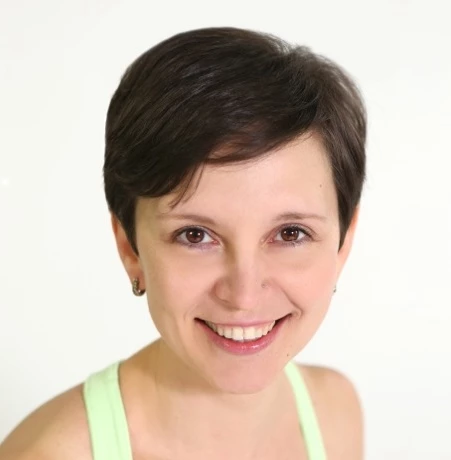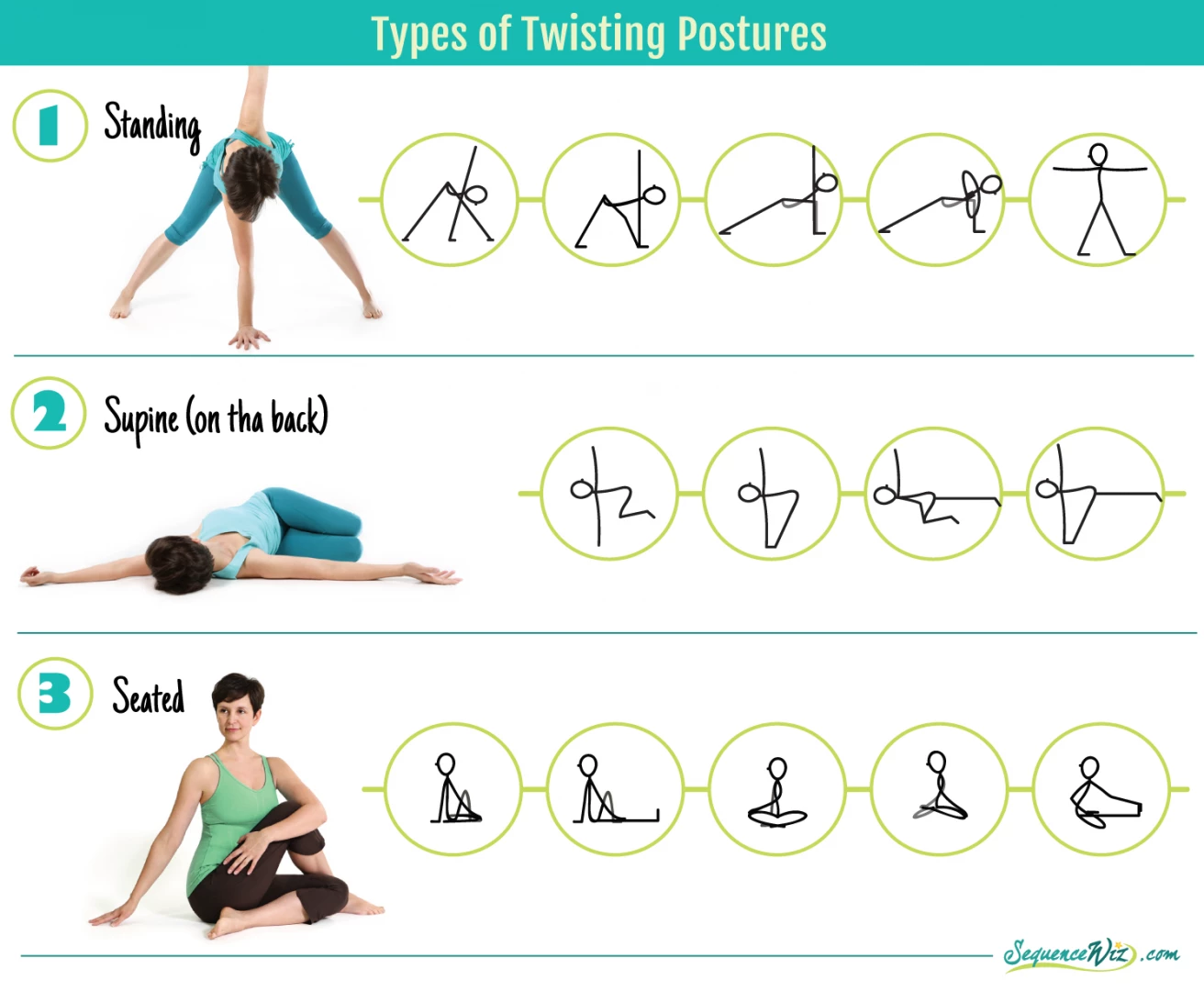Yoga Anatomy: The Benefits of Twisting Postures

Just like any other discipline, yoga has its own “lingo” that is widely used in yoga classes. The problem is that it is not always clear to the student what the teacher means. For example, I heard in a class that twists “energize the spine.” I like the idea of “energizing” my spine, but I am not sure what that means exactly. Today we will focus on twists and how they affect the body on the structural level, and we will try to use proper anatomical terminology.
Whenever we talk about structural effects of any pose, we always start with the spine. The most obvious reason for twisting is to rotate the spine. This is important not only for the sake of maintaining spinal mobility and range of motion, but also because twisting affects the spinal discs. Mel Robin writes that during twisting “the compressional force will tend to dehydrate the spinal discs as disc volume and spinal length decrease on twisting. On releasing from the twist, the discs and organs will rehydrate with fresh, healthful liquids again.” In other words, twisting helps keep your spinal discs properly lubricated.
The spine is a part of an axial skeleton, along with the skull and the ribcage. The rest of the skeleton is called appendicular skeleton; it consists of the shoulder girdle, pelvic girdle and limbs. The shoulder girdle sits on top of the ribcage and connects the arms to the axial skeleton on each side. It consists of the collar bones and shoulder blades. The pelvic girdle is more commonly known as pelvis; it links the legs to the spine.
Both structures are being held in place and moved by multiple pairs of muscles. If the muscles around the shoulder girdle get tight, they can pull the shoulder blades out of alignment, creating imbalance and tension in the upper back, neck and shoulders. Tense muscles around the pelvis can cause sacroiliac joint pain, lower back tension, hip pain and a number of other issues. Why would those muscles tense up? Mostly because of the way we use our bodies in our day-to-day lives – poor posture, lots of sitting, asymmetrical movement patterns – that sort of thing.
Twisting postures help realign the relationship between the shoulder girdle and the spine, and between the pelvis and the spine. Every time you twist your body to the right, your right shoulder blade moves closer toward the spine, contracting the muscles that bind it to the ribcage and spine. At the same time the left shoulder blade moves further away from the spine, stretching the muscles that bind it to the rib cage and spine. In most twists you keep one hip flexed and adducted (the leg is folded in toward the midline of the body), which means that the muscles on the inside of the hip will contract, and the muscles on the outside will stretch.
Alternately contracting and stretching the muscles that bind the shoulder girdle and the pelvic girdle to the spine helps realign the relationship between the appendicular skeleton and the axial skeleton. This is important because in the body it is all about the relationship between different parts. Since the body is a weight-bearing mechanism within a gravitational field, proper balance between front and back, as well as right and left is essential in keeping it pain-free and functioning properly.
There are different kinds of twists and some are stronger than others. In some twists you are only rotating the torso, and in others you use arm/leg leverage to deepen the rotation; some twists emphasize the shoulder girdle, and others target the pelvic girdle.
In most standing twists (Group 1) the shoulders/arms and pelvis/legs have relative freedom of movement. The twist becomes stronger and riskier if you use some sort of a bind, like leveraging yourself with the arms in Parsvakonasana Parivrtta (#4). The poses in this group stretch and strengthen the muscles around the spine, shoulders and pelvis. They are very effective for working with asymmetrical muscle development.
Group 2 postures are mostly variations of Jathara Parivrtti. This pose is very versatile and can be adapted in many different ways to emphasize the stretching of the neck, shoulders and upper back, or stretching/strengthening of the hips, back and legs.
Group 3 postures include different kinds of seated twists. These poses are generally stronger, both because the position of the pelvis is fixed, so the rotation happens mostly in the spine and shoulder girdle, and because we are using the arm leverage to deepen the twist.
To sum it up – structurally speaking, the primary purpose of all twists is to rotate the spine; the secondary purpose is to realign the relationship between the shoulder girdle and the spine, and the pelvic girdle and the spine. Here is the tricky part though. If you already have an imbalance in your body that manifests as sacroiliac joint pain, for example, twisting can make things worse.
Reprinted with permission from SequenceWiz.
 Educated as a school teacher, Olga Kabel has been teaching yoga for over 14 years. She completed multiple Yoga Teacher Training Programs, but discovered the strongest connection to the Krishnamacharya/ T.K.V. Desikachar lineage. She had studied with Gary Kraftsow and American Viniyoga Institute (2004-2006) and received her Viniyoga Teacher diploma in July 2006 becoming an AVI-certified Yoga Therapist in April 2011. Olga is a founder and managing director of Sequence Wiz – a web-based yoga sequence builder that assists yoga teachers and yoga therapists in creating and organizing yoga practices. It also features simple, informational articles on how to sequence yoga practices for maximum effectiveness. Olga strongly believes in the healing power of this ancient discipline on every level: physical, psychological, and spiritual. She strives to make yoga practices accessible to students of any age, physical ability and medical history specializing in helping her students relieve muscle aches and pains, manage stress and anxiety, and develop mental focus.
Educated as a school teacher, Olga Kabel has been teaching yoga for over 14 years. She completed multiple Yoga Teacher Training Programs, but discovered the strongest connection to the Krishnamacharya/ T.K.V. Desikachar lineage. She had studied with Gary Kraftsow and American Viniyoga Institute (2004-2006) and received her Viniyoga Teacher diploma in July 2006 becoming an AVI-certified Yoga Therapist in April 2011. Olga is a founder and managing director of Sequence Wiz – a web-based yoga sequence builder that assists yoga teachers and yoga therapists in creating and organizing yoga practices. It also features simple, informational articles on how to sequence yoga practices for maximum effectiveness. Olga strongly believes in the healing power of this ancient discipline on every level: physical, psychological, and spiritual. She strives to make yoga practices accessible to students of any age, physical ability and medical history specializing in helping her students relieve muscle aches and pains, manage stress and anxiety, and develop mental focus.





